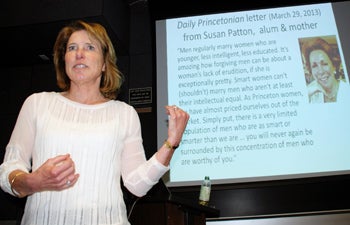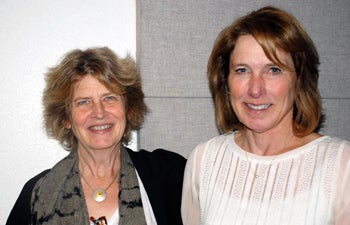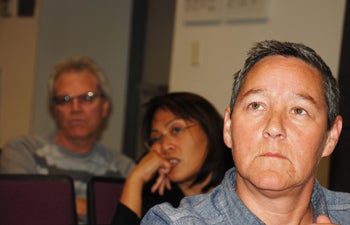Baby, I Love Your Way
If you like piña coladas and getting caught in the rain, if you’re not into yoga, if you have half a brain . . .
The lyrics to this popular ’70s song make choosing a mate sound simple.
But Wendy Wood knows better. In a recent lecture, the Provost Professor of Psychology and Business outlined exactly what kind of mate traits men and women look for — and why.
Wood began by discussing Susan Patton’s recent letter to the editor to Princeton University’s student newspaper. In her piece, Patton, a Princeton alumna, urged female students to find their husbands on campus.
Patton posited that because men regularly marry women who are younger and less educated than they, university women have almost priced themselves out of the market. She told female students that they will never again be surrounded by such a worthy concentration of men — so act now.
“One criticism of her position is how elitist it is,” said Wood, vice dean for social sciences in USC Dornsife. “So many people were turned off by this. But there are other themes in her recommendations, to those of you who are still in school, that I think are useful to consider.”

Wendy Wood, also vice dean for social sciences in USC Dornsife, pointed out a few missing pieces in Susan Patton’s recent letter to the editor of Princeton University’s student newspaper. Wood spoke during a Barbra Streisand Professor Lecture Series event last month.
Wood was speaking during a Barbra Streisand Professor Lecture Series event held April 15 on the USC University Park campus. The series is led by Alice Echols, Barbra Streisand Professor of Contemporary Gender Studies and professor of English, gender studies and history. Chair of the Gender Studies Program, Echols gave background on the lecture series.
“In the early ’80s, Barbra Streisand became interested and associated with gender studies here at USC,” Echols said. “She started attending lectures and classes, and as a result of that involvement, she endowed a professorship in the area of intimacy and sexuality.”
Since last year, the Gender Studies Program has brought to campus speakers to address subjects at the intersection of love, power and intimacy between women and men. Echols introduced Wood, a social psychologist who studies gender behavioral differences, along with behavioral habits and why they are so difficult to break.
Wood is a fellow of the American Psychological Association, the American Psychological Society, and the Society for Experimental Social Psychology, and founding member of the Society for Research Synthesis Methodology.
Returning to the Patton piece, Wood said there is some validity to Patton’s points. It’s true that people are attracted to those with similar traits, Wood said. These include education, income, personal values, religion, politics, physical attractiveness, intelligence, height, weight, interests and hobbies.
“So when the folks from Princeton tell us that maybe we should be looking for similar spouses, at least in terms of the research data on similarity, there is probably some truth to that,” Wood said.
But in addition to similarities, people look for complementarity, Wood said. The best support for that idea comes from a human-mating strategies study conducted 20 years ago by David Buss, a professor at the University of Texas at Austin.
Buss gave questionnaires to people, mostly college students, in 37 countries asking them what they looked for in a partner. In general, he found their answers were consistent with gender roles of the time.
Men preferred women who were good cooks and housekeepers. They wanted women who were chaste, physically attractive, and on average, two years younger than them. A woman’s ideal mate came with financial prospects; he was ambitious, educated, intelligent and two years older.
Buss argued that men and women have a different mating psychology established early in evolutionary history because men and women reproduce differently.

The Barbra Streisand lecture series is led by Alice Echols (left), Barbra Streisand Professor of Contemporary Gender Studies and professor of English, gender studies and history. Echols introduced Wendy Wood (right) who on April 15 delivered a lecture in the series.
“So women are what’s called the ‘investing’ gender,” Wood said. “They have to invest more in offspring right? Women have nine months of gestation, they have lactation; they can have fewer kids in their lifespan than men. So men are the less ‘investing’ sex.”
Because of these differences in reproduction, Buss argued, men and women have different mate preferences.
“If you could only have a couple of kids in your lifetime, you would be choosy, right?” Wendy asked. “You’d care about who you mated with and who you had kids with. So women have evolved a psychological disposition in Buss’ framework to be choosy and specifically to choose men with resources. So they are looking for guys who can support them and their family.”
Men have a different mating psychology, according to Buss.
“For men, the issue is how promiscuous can I be, because that’s where men’s fitness derives from,” Wood said. “So men are trying to have lots and lots of kids with lots and lots of partners. Men are interested in women’s youth and physical attractiveness because those are indicators of how fertile their partners are and how likely they are to have offspring.”
If men invest resources in their partners, they are also interested in chastity. Why? Because men can never be sure that their partners’ children are their own.
“So if the woman is chaste, then men can be certain that they are committing their resources to their own offspring,” Wood said.
However, by studying Buss’ findings, Wood, Echols and other USC Dornsife researchers found that mating preferences differed in countries depending on gender equality. Societies with a more traditional division of labor — men working, women staying home — had larger differences in mate preferences among men and women. In societies with little equality, men are more likely to look for physical attractiveness, good cooks and homemakers. Women may look for resources. But in gender egalitarian societies such as Scandinavia, women and men were looking for the same attributes.

Jack Halberstam (far right), professor of American studies and ethnicity, gender studies and comparative literature, was among audience members who had several questions for Wendy Wood regarding Wood’s presentation.
“Maybe it’s not so much evolved dispositions that we are seeing here,” Wood said. “Maybe it’s just that people are valuing the attributes that are useful for them in a given society. If you’re in a society where men go out to work and women stay home to look after the kids, you want a guy who is really good at making money. And you want a woman who’s really good at being a homemaker. People are making choices based on what is likely to be useful to them in their local society.”
As women’s roles evolve, so do mate preferences for both genders.
“What you find is that women now are much less interested in whether their partners are ambitious and industrious,” Wood said. “Men are now more interested in whether their partner is going to be a good financial prospect. They’re less interested in this housekeeper, cook thing. Both sexes are interested in attractive and sociable partners, mutual attraction, love in the relationship, education and intelligence.
“So we’re seeing a convergence of men’s and women’s preferences in the U.S. overtime.”
After the lecture and question-and-answer session, several students discussed Wood’s points.
Jennifer Labrecque, a fourth-year social psychology Ph.D. student under Wood’s guidance, emphasized the importance of offering a perspective beyond Buss’ evolutionary psychology theory. Labrecque said perpetuating the belief that men and women are programmed differently leads to unfair policymaking.
“So I think it’s really important that we understand that there are other perspectives,” Labrecque said. “We’ll see an increase in equality as long as we are able to adapt our policies to make equality possible.”